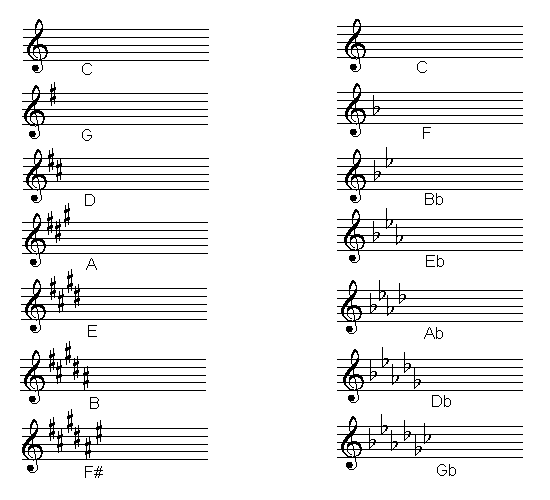Piano Lessons - Key Signatures
You may have noticed in looking at your piano sheet music that there are some symbols in the beginning of each line. If you are familiar with them, you recognize that they are sharp signs and flat signs. The sharp signs look like miniature tic tac toe boards, and the flat signs look like a lower case letter b. You may also run across a natural sign at the beginning. A natural sign is made up of two right angles put together like an L and a 7. Sharps, flats, or naturals that are found in the beginning of a piece of music are called the key signature.
The key signature of a piece of music is important because it tells the performer which notes are to be played sharp, which should be flat, and which should remain natural. These three “flavors” of each note have three different sounds, and playing music using a particular variety of each note will give a different sound to the music being played. For example, playing a piece where all of the A notes are played as A flat will sound very different than playing the same piece using A natural or A sharp instead. Composers use different key signatures for a variety of reasons. They may want the music to be high enough or low enough in the staff for a particular singer or musical instrument, so they change the key to accommodate the instrument they want to write for. Other times, the key signature is used to create a particular sound the composer had in mind. The key signature can give a piece of music an eerie sound, or a calm, relaxed sound. 
In a key signature, either sharps or flats are used to indicate which notes to play. You will never find a key signature with a mixture of sharps and flats. The order of the sharps and flats always stays the same. They are written in the same order on the staff so that musicians can quickly recognize which notes they need to play at a glance. A sharp or flat is written on the same line or space of the note it names. For example, a sharp that is written to indicate the note C sharp will be written on the space where the note C would be written. The order of the flats is BEADGCF. This means that if there is only one flat written in the key signature, it will be a B flat. If there are two flats in the key signature, they will always be a B flat and an E flat, and so on. Think of a memory device to help you remember the order of the flats, such as “bead Green Chicken Feathers.”
The order of the sharps is FCGDAEB. Use a phrase like “fat cats go dancing after eating breakfast” to remember the order of the sharps. You should practice recognizing the different key signatures so that you are very familiar with playing them. You can use flash cards to help you drill the key signatures until you are very comfortable with the order of the sharps and the flats. You can also practice writing the key signatures on staff paper to help you learn them quickly. Find sheet music with different key signatures and practice identifying the flats and sharps in them. Each specific key signature has a name. A key signature with two flats is called the key of B flat. A key signature with three sharps is called the key of A sharp. Any basic music theory book will have more information on the names of the keys and the differences between them.
Once you can identify the sharps and flats in a key signature easily, the next step is being able to play them accurately. Learning scales is one of the best ways to do this. A scale is simply all of the notes that are indicated by the key signature (notes with no sharp or flat are just played natural). Learning to play all of the major and minor scales well is one of the best ways to improve your ability to play music in many different key signatures. You should get in the habit of looking at the key signature of the music before you play any piece of music. This way, you will always be sure that you know what key the music is in before you begin to play, and your piano music will always sound the way that the composer intended.
When you're figuring out the key signature it's also a good habit to look at the time signature as well. If you're feeling comfortable with these exercises you can try playing a full song, and see if you can complete it without making any mistakes.
<< Back to More Piano Lessons ----- Improvising Piano Lesson >>
